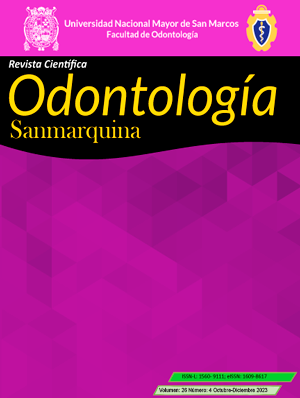Histomorphometric Comparison of Bio-Oss vs. Osteodens in Maxillary Sinus Floor Elevation Procedures
DOI:
https://doi.org/10.15381/os.v26i4.25957Keywords:
Bio-Oss, maxillary sinus, graft, histomorphometry, sinus floor augmentationAbstract
Introduction: The loss of dental elements can lead to excessive bone loss in the posterior maxillary segments, which can limit the placement of dental implants in that area, the pneumatization of the maxillary sinus and the absence of dental elements to keep the bone active are some of the main causes. Among the wide range of available grafting materials, bovine hydroxyapatite has been extensively studied and has shown excellent clinical and histological results. Materials and methods: A total of 17 maxillary sinus floor elevations were performed (n = 8 Osteodens, n = 9 Bio-Oss). After a healing period of 6 to 8 months, a block of the grafted area was obtained using trephines and analyzed by histomorphometry. Results: The percentage of neoformed bone tissue was higher for Bio-Oss (39.0% ± 11.1) compared to Osteodens (33.4% ± 8.3), while the remaining graft values were slightly lower in Bio-Oss compared to Osteodens (16.3% ± 11.2 and 20.8% ± 12.1, respectively). The proportion of connective tissue was similar in both groups (44.7% Bio-Oss and 45.8% Osteodens). Age, gender, and residual height of the sinus floor did not show statistically significant differences. Conclusions: In this study, both graft materials (Bio-Oss and Osteodens) showed no statistically significant differences in their ability to regenerate suitable bone tissue for implant placement after 6 months of healing. Further studies with a larger sample size are needed to validate these results.
Downloads
Downloads
Published
Issue
Section
License
Copyright (c) 2023 Fernando Matías Mariani, Juan Carlos Ibañez, Miriam Grenón

This work is licensed under a Creative Commons Attribution 4.0 International License.
AUTHORS RETAIN THEIR RIGHTS:
a. Authors retain their trade mark rights and patent, and also on any process or procedure described in the article.
b. Authors retain their right to share, copy, distribute, perform and publicly communicate their article (eg, to place their article in an institutional repository or publish it in a book), with an acknowledgment of its initial publication in the Odontología Sanmarquina.
c. Authors retain theirs right to make a subsequent publication of their work, to use the article or any part thereof (eg a compilation of his papers, lecture notes, thesis, or a book), always indicating the source of publication (the originator of the work, journal, volume, number and date).




















